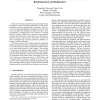Free Online Productivity Tools
i2Speak
i2Symbol
i2OCR
iTex2Img
iWeb2Print
iWeb2Shot
i2Type
iPdf2Split
iPdf2Merge
i2Bopomofo
i2Arabic
i2Style
i2Image
i2PDF
iLatex2Rtf
Sci2ools
IPPS
2007
IEEE
2007
IEEE
Achieving Reliable Parallel Performance in a VoD Storage Server Using Randomization and Replication
This paper investigates randomization and replication as strategies to achieve reliable performance in disk arrays targeted for video-on-demand (VoD) workloads. A disk array can provide high aggregate throughput, but only if the server can effectively balance the load on the disks. Such load balance is complicated by two key factors: workload hotspots caused by differences in popularity among media streams, and “fail-stutter” faults that arise when the performance of one or more devices drops below expectations due to manufacturing variations, hardware problems, or geometry-related variations. This paper focuses on the random duplicate assignment (RDA) data allocation policy which places each data block on two disks chosen at random, independent of other blocks in the same media stream or other streams. This strategy is compared to traditional single-disk file allocation, disk striping (RAID-0), disk mirroring (RAID-1), and randomization without duplication. The various allocatio...
Disk Array | Distributed And Parallel Computing | IPPS 2007 | Paper Investigates Randomization | Workload Hotspots |
Related Content
| Added | 03 Jun 2010 |
| Updated | 03 Jun 2010 |
| Type | Conference |
| Year | 2007 |
| Where | IPPS |
| Authors | Yung Ryn Choe, Vijay S. Pai |
Comments (0)

